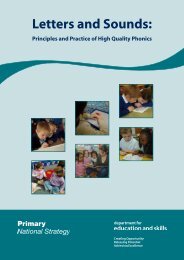Research Brief - Department for Education
Research Brief - Department for Education
Research Brief - Department for Education
Create successful ePaper yourself
Turn your PDF publications into a flip-book with our unique Google optimized e-Paper software.
Pre-school and primary school interactions<br />
• The combination of attending a higher quality<br />
pre-school and an academically effective<br />
primary school had measurable benefits <strong>for</strong><br />
pupils’ cognitive development, especially in<br />
Mathematics. High quality pre-school seems<br />
to provide some ‘protection’ against the<br />
disadvantage of attending an ineffective<br />
primary school.<br />
• Attending a more academically effective<br />
primary school was most important <strong>for</strong> pupils<br />
who had not attended any pre-school or had<br />
experienced only low quality pre-school.<br />
The EPPE 3-11 <strong>Research</strong>: Background<br />
The original EPPE study investigated children’s<br />
intellectual and social/behavioural development<br />
between the ages of 3-7 years (Sylva et al., 2004).<br />
This <strong>Research</strong> brief summarises the Key Stage 2<br />
findings of the EPPE 3-11 study, which followed<br />
up the same sample of children to Year 6 in<br />
primary school (age 11 years, the end of Key<br />
Stage 2). The findings describe influences on the<br />
sample pupils’ cognitive (Reading/English and<br />
Mathematics) and social/behavioural (‘Selfregulation’,<br />
‘Pro-social’ behaviour, ‘Hyperactivity’<br />
and ‘Anti-social’ behaviour) development, and the<br />
age 11 impact of child, family and the Early years<br />
Home Learning Environment (HLE) characteristics<br />
(Melhuish et al., 2008a). In addition, the research<br />
explores the overall influence of pre-schools and<br />
primary schools attended, and the combined<br />
impact of pre-school and primary school on pupils’<br />
developmental outcomes.<br />
The study is unique in that it also visited a subsample<br />
of 125 schools that the EPPE 3-11 pupils<br />
attended and, through observational data and<br />
questionnaires to teachers, is able to describe<br />
Year 5 classroom practices and school processes<br />
associated with a range of outcomes <strong>for</strong> a subsample<br />
of 1160 pupils. The study also explores<br />
the relationship between pupil outcomes and<br />
‘other’ measures of school experiences in these<br />
125 schools (Ofsted judgements).<br />
The EPPE technical reports and the website:<br />
www.ioe.ac.uk/projects/eppe provide further<br />
details about the research and findings.<br />
Data and Analysis Strategy<br />
The findings summarised here are based on<br />
analyses of measures of EPPE 3-11 pupils’<br />
cognitive outcomes derived from (Year 5) NFER<br />
tests of Reading and Mathematics, and (Year 6)<br />
Key Stage 2 National assessment scores in<br />
English and Mathematics. The analyses included<br />
2701 pupils in over 950 primary schools.<br />
Social/behavioural outcomes (4 dimensions: ‘Selfregulation’,<br />
‘Hyperactivity’ ‘Pro-social’ and ‘Antisocial’<br />
behaviour) were obtained from teachers’<br />
assessments using an extended version of<br />
Goodman’s Strengths and Difficulties<br />
Questionnaire (1997).<br />
Pre-school quality was measured by observation<br />
in 141 pre-school settings using the ECERS-R<br />
(Harms et al., 1998); focusing on emotional and<br />
social care and ECERS-E (Sylva et al., 2006);<br />
focusing on the pre-school curriculum.<br />
Effectiveness indicators <strong>for</strong> individual pre-school<br />
settings were calculated using value added<br />
models of children’s progress during the preschool<br />
period (Sammons et al, 2002; 2003).<br />
Value added measures of overall primary school<br />
academic effectiveness in English and<br />
Mathematics were derived from independent<br />
statistical analyses of National assessment data<br />
sets <strong>for</strong> all pupils in all state primary schools in<br />
England in 3 successive years (2002-2004,<br />
Melhuish et al., 2006). This enabled the research<br />
team to locate each primary school attended by an<br />
EPPE pupil on a scale of ‘academic effectiveness’,<br />
after controlling <strong>for</strong> pupils’ prior attainments and<br />
other demographic characteristics of each school’s<br />
intake.<br />
Background in<strong>for</strong>mation <strong>for</strong> the EPPE 3-11 pupil<br />
sample was derived from interviews with and<br />
questionnaires to parents. We investigated the<br />
influence of different child, family and Early years<br />
HLE background factors as predictors of EPPE 3-<br />
11 pupils’ attainment and development at age 11<br />
and their progress over Key Stage 2 from age 7 to<br />
11 (Sammons et al., 2007a; 2007b; 2008a;<br />
2008b). These analyses identify the unique (net)<br />
contribution of particular factors to pupil outcomes,<br />
while other background influences are controlled.<br />
In<strong>for</strong>mation on school and classroom practices<br />
and processes were obtained from observations in<br />
a sub-sample of 125 schools (whilst pupils were in<br />
Year 5) and questionnaires to teachers and pupils.<br />
The data enabled the research to establish<br />
developmental profiles and learning trajectories <strong>for</strong><br />
each pupil that included cognitive and<br />
social/emotional assessments as well as family<br />
demographics and in<strong>for</strong>mation on pre-school<br />
settings and the primary school each pupil<br />
attended.
















